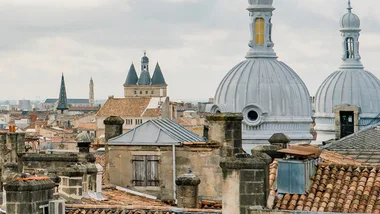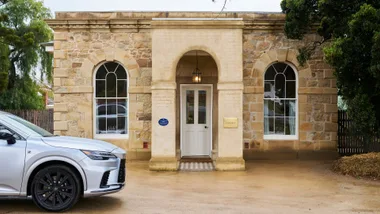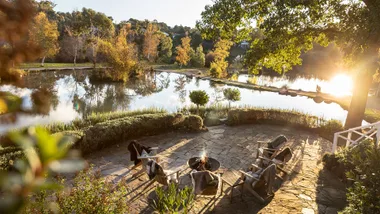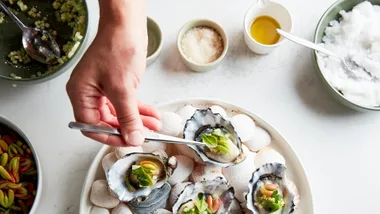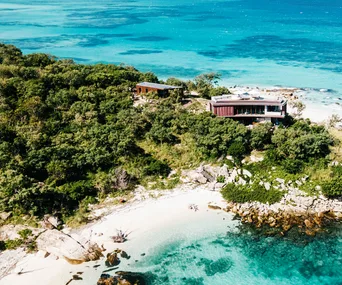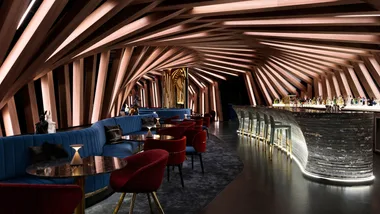GETTING THERE
From New York City, rent a car, take a seaplane or helicopter, or hop on a coach (the famed Jitney) or the Long Island Rail Road, a three-hour trip from Manhattan’s Penn Station.
STAY
The 86-year-old dowager has 105 rooms, amiable service and a nautical colour scheme. There’s a marina, three pools, restaurants and lounges. Rooms from $807 in summer. 32 Star Island Rd, Montauk, +1 631 668 3100
In the centre of town, this hotel has pool parties, art shows and 33 handsome rooms with industrial flourishes. From $674. 55 South Elmwood Ave, Montauk, +1 631 668 2112
Stay in one of the 20 surfer-chic waterfront rooms, and the party is on your doorstep. Artists at its concert series have included Willie Nelson. Rooms from $576. 183 Edgemere St, Montauk, +1 631 483 5037
This refined hotel on the Atlantic has had a multimillion-dollar refit featuring contemporary furnishings, fine dining, and a world-class spa. It’s one of the only full-service resorts in Montauk, with 179 rooms and open all year. From $674. 290 Old Montauk Hwy, Montauk, +1 631 668 2345
EAT
541 East Lake Dr, Montauk, +1 631 668 4272
34 South Etna Plaza, +1 631 668 3663
352 West Lake Dr, Montauk, +1 631 668 3474
4 Old West Lake Dr, Montauk, +1 631 668 2077
The grounds and restaurant might resemble a Wes Anderson playground but dishes such as clam fritters and spaghettini with crab are serious. 161 2nd House Rd, Montauk, +1 631 668 2877
This Mexican taqueria serves shrimp a la plancha tacos and tilefish ceviche. 752 Montauk Hwy, Montauk, +1 631 668 8338
Dine on the sand at this popular eatery serving clam and corn chowder, calamari salad and whole branzino. 16 Navy Rd, Montauk, +1 631 668 6868
A tough reservation to snag but it’s worth the trouble for its celebrated cioppino. 468 W Lake Dr, Montauk, +1 631 668 9190
DRINK
Lynn’s Hula Hut
426 W Lake Dr, Montauk, +1 303 482 5047.
148 Emerson Ave, Montauk, +1 631 647 8000
Liar’s Saloon
401 W Lake Dr, +1 631 668 9597.
Montauket Hotel
A high-energy bar with live music and spectacular sunsets. 88 Firestone Rd, Montauk, +1 631 668 5992.
SHOP
102 Industrial Rd, Montauk, +1 631 668 9080
Whalebone Creative
Hand-printed T-shirts, handbags, and accessories infused with surfer style. 65 Tuthill Rd, Montauk.
Colourful kaftans, prismatic swimsuits and accessories for women. 99 The Plaza, Montauk, +1 631 668 4999
Vintage clothing plus bibelots sourced from Kenya to Mexico. 805 Main St, Montauk, +1 631 483 5048
Only 20 kilometres separate the village of Montauk from the Hamptons, yet the destinations are worlds apart. Long Island is where generations of New Yorkers have come to play in summer, a coastal rite of passage that plays out due east of Manhattan, beyond the city’s gritty exurbia. Where one stops along the way speaks volumes. Southampton, Sag Harbour and East Hampton are gilded enclaves, with manicured hedges, meticulous shingled houses and Gatsby-esque wealth on brazen display. The Hamptons is where old money meets the nouveau riche, where luminaries rub shoulders with hedge-fund moguls in a flashy, occasionally combustible mix. With high society comes high anxiety, as the social one-upmanship of the city is transferred to the beach.
And then there’s Montauk. Its residents refer to it as “The End”, as in the end of the line, and in some cases that’s literal as well as metaphorical. Located on the easternmost tip of Long Island, it’s a scruffy, sleepy seaside community. To get there you must traverse the Napeague Stretch, a wind-swept road flanked by vast wetlands, dusty green shadbush and the occasional clam bar. The air is saltier here, the waves curlier, and the inhabitants less noticeably neurotic. There’s little conspicuous affluence, few hedgerows. In other words, it’s the un-Hamptons. A proudly blue-collar fishing hamlet with a bohemian surfer vibe, Montauk has been evolving as a resort town for decades.
I live on the west coast of the United States, but each summer I’m reflexively drawn to Long Island, and the siren call of Montauk is especially irresistible. From June through to September, the population swells from 3000 permanent residents to well over eight times that number. For five days this past summer, I trawled fish markets, ordered Shark Bites at meat-market bars, stayed at new-fangled hotels, and stretched out on the village’s pristine beaches. What I rediscovered is a village that balances its rustic charms with splashes of urban glamour. Somehow Montauk has retained its status as the un-Hamptons. It’s a place where you can master yoga paddleboarding, feast on local seafood at the beach, and watch the sun dive with a live soundtrack. Even the most jaded Hamptonites find it hard to resist.
I drive through the village centre to the Montauk Point Lighthouse, an historic landmark for more than 200 years, at the end of Montauk Highway. It’s in one of the area’s many preserved parks – almost 70 per cent of local land is protected from development – which contribute to Montauk’s sweet languor. Crossing these parks is an extensive marked trail system with hiking tracks, mountain-bike paths, and secluded ponds for kayaking. Not far from the lighthouse is Andy Warhol’s former estate, the most expensive property in the village, now owned by J Crew CEO Mickey Drexler. In the 1970s, John Lennon, Lee Radziwill, Halston and Liza Minnelli arrived as guests, and The Rolling Stones, too, who penned “Memory Motel” about a Montauk bar that still pulls a crowd. These days, Ralph Lauren, Jann Wenner, Julian Schnabel and Robert De Niro number among Montauk’s better-known inhabitants.
One of my first stops is the home of Ben Watts. The British-Australian photographer, a resident at the beach for more than a decade, is regarded by some as the unofficial town mayor. “New York is a grind and when you come out here it’s paradise,” he says.
He pours glasses of Watts Up Rosé, a Spanish-varietal blend he created with online retailer Wine Awesomeness, and shows me around his house. There’s a Union Jack-covered chaise, a stag skull on a wall and an Airstream trailer out front.
“Montauk has raised its flag as a cool, trendy and younger Hamptons,” he says. “If you live in Paris you need to fly to the south of France to escape. Here you can just drive in three hours.” Well, make it four in traffic, but who’s counting? Watts hosts an annual shindig called Shark Attack Sounds. At the bash in 2013 more than 3000 revellers gathered at Montauk Yacht Club for a rollicking party with blow-up sharks, an enormous mirror ball and well-known DJs. Last summer’s event, which unfolded at the beachfront resort Gurney’s, was a little more subdued but no less celebratory.
I check in to the Montauk Yacht Club a few hours later. It’s a relaxed resort from the 1920s, popular with a chilled-out crowd, families and couples tying the knot. In the intervening years it’s been retooled several times, most recently in 2009, and embellished with maritime touches such as blue and white striped wallpaper and pearl-disc chandeliers. A handful of guests enjoy cocktails at an open-air bar, gazing at the harbour dotted with yachts, while others clad in terry-towelling robes are floating back to their rooms after spa treatments. The vibe, like so much of Montauk, is breezy and understated. There’s wealth, for sure, but no ostentation. I’ve planned dinner with friends at nearby Inlet Seafood. Owned by local fishermen, the restaurant has a boat-to-table approach that delivers the freshest of fish. We gather by the windows, order bowls of mussels piled high in a chardonnay and garlic broth as well as expertly grilled Montauk lobster, and thrill to the orange-red sunset.
Next morning I make a beeline for Ditch Plains, a picturesque beach bracketed by jagged cliffs and known for its offshore break. This spot has a special resonance for me. On an earlier trip, I spent three days here on a surf camp and first learned how to pop up on a board. It’s seven o’clock, and just beyond the first Atlantic swell I count 32 surfers bobbing in the sea. Although it’s summer, the water remains chilly and everyone’s wearing a wetsuit. I watch a couple in their 50s make their way out, expertly tiptoeing over the pebbly shore, deftly clutching their boards under one arm, their free arm outstretched. Behind the dunes a flock of earlybirds is gathering. They order iced coffee from Ditch Witch, a takeaway wagon in the car park, and catch up with friends and neighbours. “Barry, are you going to Grace’s birthday today?” asks a woman. “My dog is a chihuahua,” announces another woman above the din. “He can speak Spanish.” I wonder if her bilingual canine can read the sign above: “Please keep off the dunes.” A hurricane in 2012 eroded the fragile shoreline, and local authorities are trying valiantly to save the dunes.
After a smoothie and breakfast wrap at Joni’s Kitchen, a crowd-pleasing spot in town, I drop by Melet Mercantile to admire the beach-centric wares curated by respected vintage dealer Bob Melet. It’s a magpie’s fantasy: fibreglass sharks, rock T-shirts, indigo textiles from Africa, beaded bibelots and books about Donald Judd and Allen Ginsberg.
“We get a lot of Aussies in Montauk,” says Frida Kamau, an artist who’s running the store. It’s probably because the coastal village reminds us of home, a sentiment that’s echoed by every Australian expatriate I encounter. I stop for lunch at Westlake Fish House, a year-old restaurant on the dock, where diners can watch fishermen unload the catch of the day. Chef Larry Kolar divides his kitchen into east and west, turning out shrimp tempura rolls and swordfish BLTs. Later, the chef and I head to nearby Gosman’s Dock, Montauk’s fish market. As Kolar shows me around, he points out a large cold room. “I’ve seen 15,000 pounds [6.8 tonnes] of swordfish right here,” he says, beaming.
Fishing is Montauk’s mainstay, but for a long time the village, settled by Europeans in the 17th century, existed as a cattle ranch. It became a military installation in the 18th century and the US Navy established a station here during World War I. Next came the fishermen, then surfers, and lately the hipsters have been massing. There’s occasional resistance to the latter migration, seen in the sign at an old-school haunt: “Leave attitude at the door”. At Lynn’s Hula Bar, a Gilligan’s Island-like tiki bar on a marina, I strike up a conversation with a grizzled fisherman nursing his Budweiser. “Montauk was a special place and then came the fedoras and the skinny jeans – on guys,” he says, fixing me with a suspicious glare.
You can still tap into classic Montauk if you desire. The annual round of shark tournaments started soon after I left, when hundreds of fishermen attempt to wrangle the biggest thresher, blue or mako shark for prize money. The shark-fishing craze began here in the 1970s, the inspiration for Jaws author Peter Benchley.
“Montauk has become so much busier in the last couple of years but it’s still refreshingly authentic,” says Walt Lindveld, creative director of The Montauk Beach House. When we meet, the hotel is gearing up for one of its regular pool parties, but it plays out in orderly fashion and winds down in a few hours. Montauk is not Ibiza. There are no super-clubs, or raging day-parties. For every hotspot like The Sloppy Tuna, with its $12 cocktails and clubby air, there’s a dive bar like Liar’s Saloon, where patrons, mostly locals and gnarled fishermen, enjoy dollar draught beer and karaoke. Even The Surf Lodge, which opened in 2008 and was once swamped with carousers, has spruced up its party-hard image. The 20-room hotel and beach club now hosts cultural events and has installed reputable chefs, Australian Chris Rendell and Briton Michael Hamilton. On the Sunday I visit, the mood of the waterfront lounge is more jubilant than decadent.
On stage is a blues band, and a DJ spins tunes between sets. Dan Auerbach from the Black Keys is in the crowd of pretty young things in jumpsuits and sculpted guys in pastel shirts and shorts.
Although there’s no beach at The Surf Lodge – it overlooks Fort Pond – there is a sand-filled outdoor bar, a ship’s mast and a collection of hand-painted surfboards on show. The dreamy interiors of the hotel, conceived by designer Robert McKinley, feature driftwood furniture, hanging rattan chairs and hammocks in every room. Ben Watts’ vibrant photography hangs in the restaurant; the deck is festooned with cane chandeliers. “Montauk has a unique charm,” says Jayma Cardoso, one of The Surf Lodge’s owners. “It almost feels like an island, with the Napeague Stretch that you drive in on serving as a land bridge. When you reach an end-point like this it forces you to stop and really focus on the surrounding beauty.” Cardoso and her partners are also focusing on Surf Lodge satellites. “For us, the real pleasure is finding new destinations that reflect their natural beauty. We’re exploring locations in California and my native Brazil.”
This is not the first time that Montauk has capitalised on its convivial atmosphere. In the 1920s, developer Carl Fisher envisaged a summer playground that was the “Miami of the north”. He built the golf course, the yacht club, and several Tudor-style buildings that are still standing. His grand vision collapsed when the stock market crashed in 1929, yet Montauk’s popularity as a tourist attraction continued to grow. Fisher, I think, would have been impressed with Gurney’s, a resort where guests lounge under beach umbrellas, savour Montauk pearl oysters and indulge in seawater treatments at the spa.
My final meal in Montauk is at The Crow’s Nest, the tranquil inn and restaurant established by New York hotelier Sean MacPherson four years ago. The evening begins with a gin-powered cocktail called The Summer Rental, devised by resident mixologist Hunter Orahood. A flurry of transporting dishes follows, including crisp kale sprouts with a blend of raw and baked leaves, a multicoloured beet salad atop an earthy beet purée, and Jonah crab tagliatelle. The amalgam of fresh seafood, organic vegetables and adventurous technique is unparalleled in Montauk. “Few people out here are concentrating on vegetables, but we do,” chef Jeremy Blutstein tells me. “There aren’t really any farms in Montauk, so we source from vendors in East Hampton and Amagansett.”
Even with the gentrification of the past few years, all the new high-end restaurants and boutiques, Montauk will never be as gold-plated as the Hamptons. The winding roads, rolling dunes and craggy coastline lend it a timeless allure. “What Montauk enjoys that other hamlets don’t is special zoning,” says Paul Brennan, of Douglas Elliman Real Estate. “It will grow and mature but it will never get to the grandeur of places like Southampton and East Hampton. It’s a younger set than the Hamptons, since it’s really the only place on the island where nightlife happens now.”
That night, driving to my hotel, a deer bolts across the road, dangerously close. It’s the second time this visit I’ve narrowly avoided a collision. Montauk might be The End but I don’t care for it to be the end of me. It’s a reminder of how wild Montauk remains – a free-spirited, languid and idyllic respite from the chaos of city life.

 Nikki Fenix
Nikki Fenix
